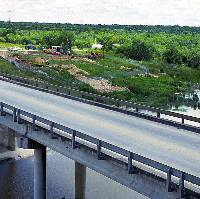
View of Pavo Real excavations in
progress during the investigations of the site's Archaic
deposits, summer of 1979.
Click images to enlarge
|
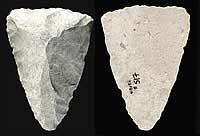
Both faces of a unifacial Clear Fork
tool, probably used for wood-working. These have been
found in Paleoindian and Early Archaic contexts elsewhere;
this one is probably an Early Archaic artifact.
|
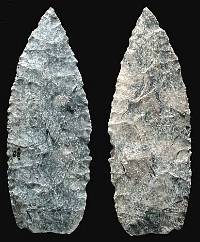
Both faces of a large, thin knife
(biface) made of a dark chert unlike that found at Pavo
Real. Date unknown, possibly Late Archaic.
|
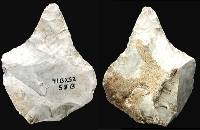
Odd looking tool that resembles a
miniature version of a "fist axe," a specialized
tool type commonly found in Late Archaic contexts in
the southern Edwards Plateau.
|
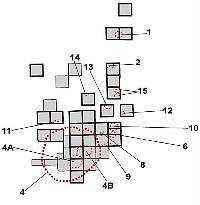
Plan map of main Archaic excavation
units showing the location of the burned rock midden
(4) and most of the hearths. The features are numbered.
|
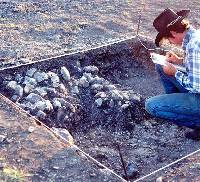
Crew member sketches a partially
exposed cluster of burned rocks that may be an irregular
hearth. During the Archaic dig, many of the excavations
units were not connected to one another. As a result,
partially exposed features such as this one were difficult
to evaluate.
|
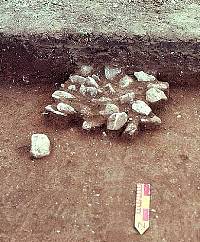
Small hearth (Feature 8) that appears
to have a rectangular shape. Most hearths at central
Texas Archaic sites are circular to oval in outline
shape.
|
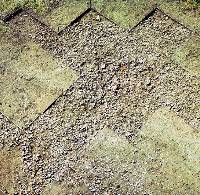
Overhead view east-southeast of the
burned rock midden (Feature 4) after initial exposure.
The image was taken from a hydraulic lift. Note the
irregular shallow depressions with darker soil and a
few larger rocks near the center of the photograph and
in the central part of the midden. Later excavations
revealed remnants of two large features in this area. |
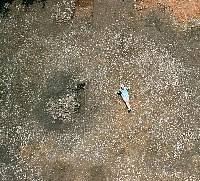
This overhead photo of the burned
rock midden at the Higgins site clearly shows the dark-stained
central cooking pit and the large rocks representing
the remains of a large earth oven. Click to see the
enlarged view and you will also see that there were
two large ovens just outside the midden.
|
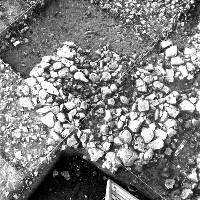
Overhead view southeast of the lowest
exposed portion of Feature 4B. This oval pattern of
rock probably represents most of an intact heating element
from a sizable earth oven about seven feet in length.
|
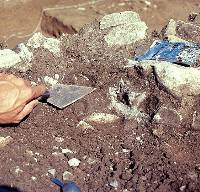
Archeologist points to a small fragment
of charred wood found between the large rocks of Feature
4B, one of the large hearths/earth ovens found in the
midden at Pavo Real. The charcoal sample was later dated
to about 4,000 years old (2000 B.C.).
|
|
The Archaic deposits proved to be shallow—no
more than 80 centimeters (31.5 inches) thick and sometimes
only half that. The shallow Archaic deposits also contained
a mix of artifacts of different ages including dart points
perhaps 2000 years old, others perhaps 9,000 years old, and
many dating to between these extremes. Unfortunately, artifacts
of mixed age were often found together in the same layers.
This is because the Archaic deposits formed atop a stable
surface to which very, very little sediment was added. Radiocarbon
assays from the site and the dart point styles suggest that
the Archaic deposits formed intermittently over a span
of perhaps 7,000 years, from sometime in the Early Archaic
(ca. 7,000 B.C to the latter centuries B.C.).
This means that, roughly speaking, there was
a maximum 1 centimeter (about 3/8 of an inch) of deposition
for every 100 years of the Archaic occupation span. Of course,
most of the deposition must have occurred in erratic spurts
separated by lengthy periods of stability and intermittent
erosion. Nonetheless, this calculation pretty much sums up
the main problem with the Archaic deposits—too much time
represented by too little deposition.
The site's Archaic artifacts are similar to
those found at many other Archaic sites. The table below shows
a breakdown by general category of the Archaic artifacts.
Most are pieces of tool-making debris (debitage) or fragments
of bifaces (two-sided shaped pieces) that were broken during
manufacture before being finished as knives or dart points.
Among the projectile points were only three fragments of arrow
points dating after A.D. 800 and some 184 dart points dating
mainly to the Middle and Late Archaic periods. Because the
Archaic artifacts of differing ages were mixed together, there
wasn't much that could be learned from them that isn't already
known from studies of other sites in the region. Photographs
of a few of the site's more unusual Archaic artifacts can
be seen in this section.
|
Debitage
|
36,214
|
|
Cores
|
178
|
|
Flake Tools
|
306
|
|
Unifaces
|
25
|
|
Early Stage Bifaces
|
137
|
|
Late Stage Bifaces
|
105
|
|
Undiagnostic Dart Points
|
40
|
|
Diagnostic Dart Points
|
144
|
|
Arrow Points
|
3
|
|
Ground/Battered Stone
|
2
|
|
Total Archaic Artifacts
|
37,154
|
More informative than the artifacts were the
site's features—discrete clusters representing mainly
cooking activities. A total of 19 Archaic features was documented
at Pavo Real; three were burned rock middens, 15 were individual
features (hearths and clusters), and one was a burned tree
root.
Of the three burned rock middens, Feature
4 was the main focus of investigation and was found to be
an annular (ring-shaped) midden that had remnants of two large
hearths (Features 4A and 4B) in its center. Feature 3 was
a sheet midden (single layer of rock) within which no internal
features were recognized. The other midden was only minimally
investigated, so its size and form were not determined.
Most of the smaller features (hearths) occurred
around the midden in a small hearth field. Of the 15 individual
hearths and burned rock clusters, three partially exposed
clusters cannot be confidently classified as hearths.
Of the 12 remaining individual features, all are regarded
as hearths. Four are small hearths less than 1 m in
diameter, 6 are medium hearths having a diameter of
1-1.5 m, and two are large hearths having a diameter
of at least 2 m. While the size distinctions are somewhat
arbitrary, there do seem to be three distinct size classes
of hearths that may have important functional implications.
In the technical report, each of these hearths
is described and considered in detail. Frankly, for most we
have little to go on apart from their size and shape. Organic
materials (like charred plant remains and animal bones) were
preserved very poorly, if at all, at Pavo Real. So basically,
all that is left are the burned rocks. The accompanying photographs
show some of the range of variability. Black thinks that most
of the hearths were once part of earth ovens of various sizes.
Significantly, the larger hearths were found
near the center of the site's largest burned rock midden,
while all those outside the midden were smaller. This pattern
suggests that larger amounts of certain kinds of foods (very
likely bulbs and roots) were baked in a designated cooking
pit around which the midden formed. In contrast, it is obvious
that smaller amounts of food were prepared in the smaller
hearths. Black speculates that a wider range of foods may
have been cooking in the smaller hearths/earth ovens, perhaps
including meat and plant foods requiring relatively short
cooking times. These ideas will have to be evaluated at other
Archaic sites where better preservation conditions prevail
and direct evidence of food can be found.
Although charred plant remains were scarce,
a few small samples of charred wood were recovered from the
burned rock midden, its internal features, and two of the
hearths in the surrounding hearth field. Seven radiocarbon
dates were obtained. Of these, six (including all four from
the midden) formed a tight cluster of dates between about
1900-2400 B.C. The seventh date was about 3500 B.C. and came
from one of the hearths. These dates suggest that the main
period of Archaic use (or at least the main time during which
most of the hot rock cooking was done) was during the Middle
Archaic and early part of the Late Archaic.
Anatomy of a Burned Rock Midden
The largest and most complicated feature recorded
at Pavo Real is the burned rock midden (BRM) designated as
Feature 4. It was also the focus of investigation and better
documented than most of the hearths. As the excavations progressed,
it became apparent that the overall form of the midden was
annular or ring-like, with a central area within which were
clusters of large rocks surrounded by a ring made up of densely
packed rocks of uniformly small size. Two adjacent remnants
of large, circular hearths (Features 4A and 4B) were documented
within the central area of Feature 4.
The TxDOT archeologists began the investigation
of the midden by exposing much of its surface prior to further
excavation. By doing so, they were able to recognize the existence
of the internal features, Feature 4A and 4B. In 1979 this
was an important discovery because archeologists had not yet
realized that most burned rock middens formed around central
cooking areas. In part this was because most of us didn't
have a very good excavation strategy for investigating middens.
And I (Black) should know.
As Pavo Real was being investigated in 1979,
I was in charge of the excavation of the Panther Springs
Creek site (41BX228) a few miles to the east. We were
investigating five middens there and, instead of trying to
expose the upper surface of any one of them, we dug through
each of them with small excavation pits and narrow backhoe
trenches. As a result, we just saw thick layers of jumbled
rocks and did not perceive any overall organization to the
middens. I am now confident that each of those middens probably
had central cooking areas similar to the one found at Pavo
Real.
One reason I think this is because in 1993 I
also had the opportunity to excavate another burned rock midden
at the Higgins site (41BX184) directly across Panther
Springs Creek from the site I just mentioned. At the time,
I still thought that most middens were just unstructured piles
of discarded cooking rocks and that the actual cooking had
taken place in hearth fields around middens, but not in them.
(I knew about the internal features at Pavo Real, but thought
these were the exception to the dominant pattern.) But when
we used a Gradall to expose the top of the Higgins midden,
we found a dark-stained central pit within which was a large
"hearth" quite similar to those found at Pavo Real.
Other archeologists have since found similar patterning at
dozens of other middens in central Texas.
Back to Pavo Real. The accompanying photographs
show why the technique of exposing the entire surface of a
midden is an effective way to understand its structure. By
laying bare almost the whole accumulation and then selectively
removing the smallest rocks from the central area, the distinctive
patterns of the two internal "hearths" could be
clearly seen. The midden had an overall circular pattern
near the center of which was an area pitted by several irregular
shallow depressions. In the pitted central area, as compared
to surrounding mass of rocks (the ring), the soil between
the rocks was darker and there were some very large rocks.
Eventually, two partial rings became apparent and it was realized
that these were remnants of two large internal features side-by-side
within the central area.
The lower part of the central area revealed
a more complex situation than was reflected on the midden's
upper surface. Feature 4B proved to be an intact oven bed,
while most of the larger rocks in Feature 4A formed a crescent
shape around a depression that was apparently devoid of larger
rocks. Based on the existing records and on experience with
other middens, I believe that Features 4A and 4B represent
the superimposed, juxtaposed, and mixed remnants of many similarly
constructed cooking features built within the center of the
midden. Each successive cooking event would have impacted
the configuration of the central area, new pits, enlarged
pits, rock robbing and reuse, sediment stripping (for earth
to seal ovens), etc.
Feature 4 and its internal features are interpreted
as the remains of an earth oven facility that was reused
dozens of times (but not hundreds) over a period of at least
300-400 years during the Middle Archaic and early Late
Archaic. It is a good example of a "classic" central
Texas BRM as defined by my colleagues and I in a 1997 study.
The two central features suggest that the midden accumulated
as the result of the repeated construction of large ovens
about 2 meters (6 feet) in diameter with substantial heating
elements (beds). No plant or animal remains were recovered
apart from a small amount of charcoal from the fuel wood.
Nevertheless, based on what has been learned in the last decade
from other BRMs in the region, it seems likely that Feature
4 was used to process bulk quantities of some sort of roots
or geophytes such as lily family bulbs, sotol, or possibly
yucca.
I calculate that Feature 4 could represent
about 40 earth oven events. If we assume that the cooking
episodes took place over a 300-year span (as suggested by
the radiocarbon dates), the midden could have formed as the
result of one site visit and earth oven use every 7.5 years.
This calculation is mentioned only to make the point that
Pavo Real was just one of many convenient stopping places
along Leon Creek and so many other stream valleys located
a short distance from the places where root foods grew (some
grow in stream valleys, others on rocky slopes; both are near
Pavo Real). Every so often when plant densities and/or human
needs drew people to this spot, another oven or two was built
and fired. In other words, small burned rock middens do not
imply intensive occupation, nor do they necessarily imply
intensive use of a particular resource. They imply a strategy
of gathering and baking relatively large batches of food resources
(roots and bulbs) that took a lot of time and effort relative
to the amount of caloric energy represented by the food.
Why would anyone have gone to such trouble?
I suspect the answer is fairly simple: they didn't have much
choice. Faced with starvation during the winter and early
spring when virtually no other plant foods are available,
when hunting was unsuccessful and stored foods were exhausted,
Archaic peoples had no recourse but to eat roots. Why,
you might ask, didn't they just pick up and move where food
was more plentiful? No doubt they did whenever they could,
but by Middle Archaic times (about 5,000 years ago) there
were lots of hunting and gathering people throughout the region
and there was no place left to move to that wasn't already
occupied. This simplified explanation is speculative, but
it seems to fit the growing body of evidence from Pavo Real
and many other sites on and near the Edwards Plateau.
|
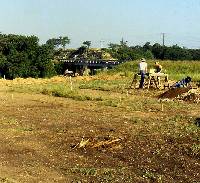
Initial test excavations underway,
May, 1979. Archaic artifacts and burned rocks were exposed
on the surface. The area had apparently been cleared
and graded in the past, probably removing some of the
top few inches of soil.
|
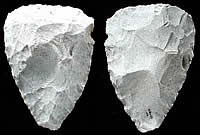
Both faces of a bifacial Clear Fork
tool, probably used for wood-working. It probably dates
to the Early Archaic.
|
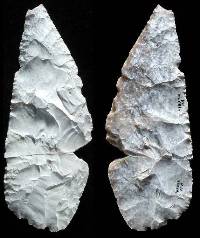
Both faces of an asymmetrical knife
(biface) that was broken during excavation. Notice that
one face is completely white with patination (weathering),
while the other face has an unpatinated edge that shows
the original color of the artifact. The material is
not local. The unpatinated edge indicates the artifact
was picked up long after it was originally abandoned
and partially resharpened. This sort of recycling was
probably a lot more common than archeologists realize.
|
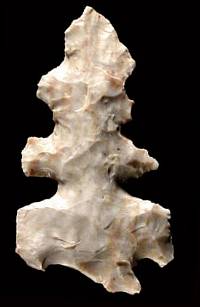
"Eccentric" dart point
fragment with multiple notches. Artifacts like this
are never common and are thought to be practice pieces
used by a flint knapper perfecting the difficult technique
of creating narrow notches. This style of notching is
found on Andice and Bell dart points dating to the early
Middle Archaic period (several fragmentary examples
of these styles were found at Pavo Real).
|
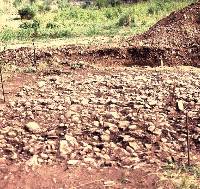
This partially excavated sheet midden
(Feature 3) appeared to be a single layer of burned
rocks covering an area at least 4.5 meters (14.6 feet)
across. Sheet middens like this one may represent places
where several earth ovens were built and dismantled,
but were not used long enough for a full-scale midden
to form.
|
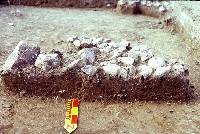
Medium hearth (Feature 6) about four
feet across after it has been sectioned (removing one
half). As this cross-section view shows, the hearth
was built on a flat surface. All of the hearths at Pavo
Real were built on flat surfaces or placed in shallow
basins.
|
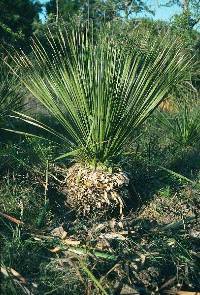
Sotol (Dasylirion sp.) has a large
bulb (head), most of it is fiber. Only the innermost
leaves are edible and then only after prolonged baking
for up to 48 hours. Yet, prehistoric peoples apparently
ate quite a bit of sotol at times, probably because
it was one of the few foods reliably available in crisis
times—winter/early spring and during droughts.
Although no sotol was identified at Pavo Real, it may
have been among the plants cooked in the larger hearths
within the midden. There are many other species of potentially
edible roots and bulbs (geophytes).
|
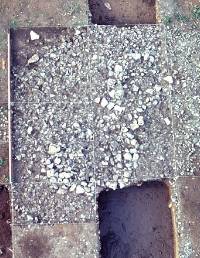
Overhead view south of central area
of Feature 4. The two emerging internal features, both
partial rings, are clearly visible. The larger ring
toward the bottom of the photograph is Feature 4B, while
the smaller ring is Feature 4A. Recent rain made the
large upper rocks of the two internal features stand
out against the darker, wetter, and smaller rocks of
the main midden mass.
|
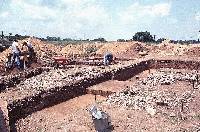
View of the burned rock midden excavations
at Pavo Real, looking northwest. Here, a row of excavation
units has been dug through the midden in search of earlier
Archaic layers. The deeper units cut through the central
midden area and the two large internal features. Portions
of these are still visible on the right.
|
|